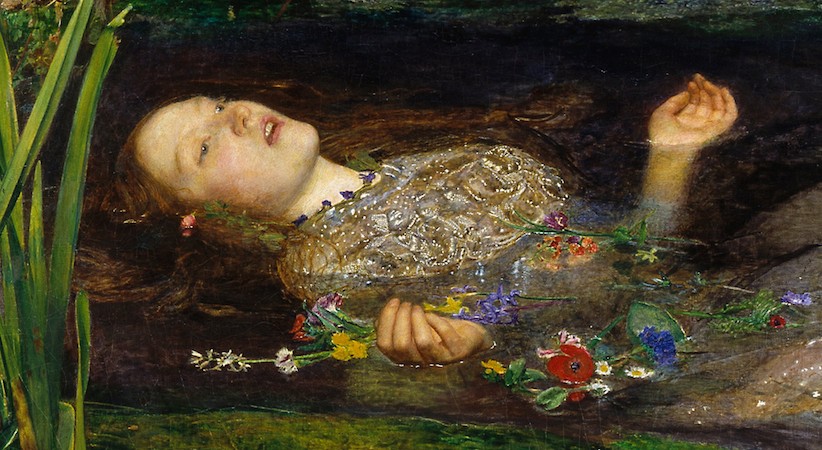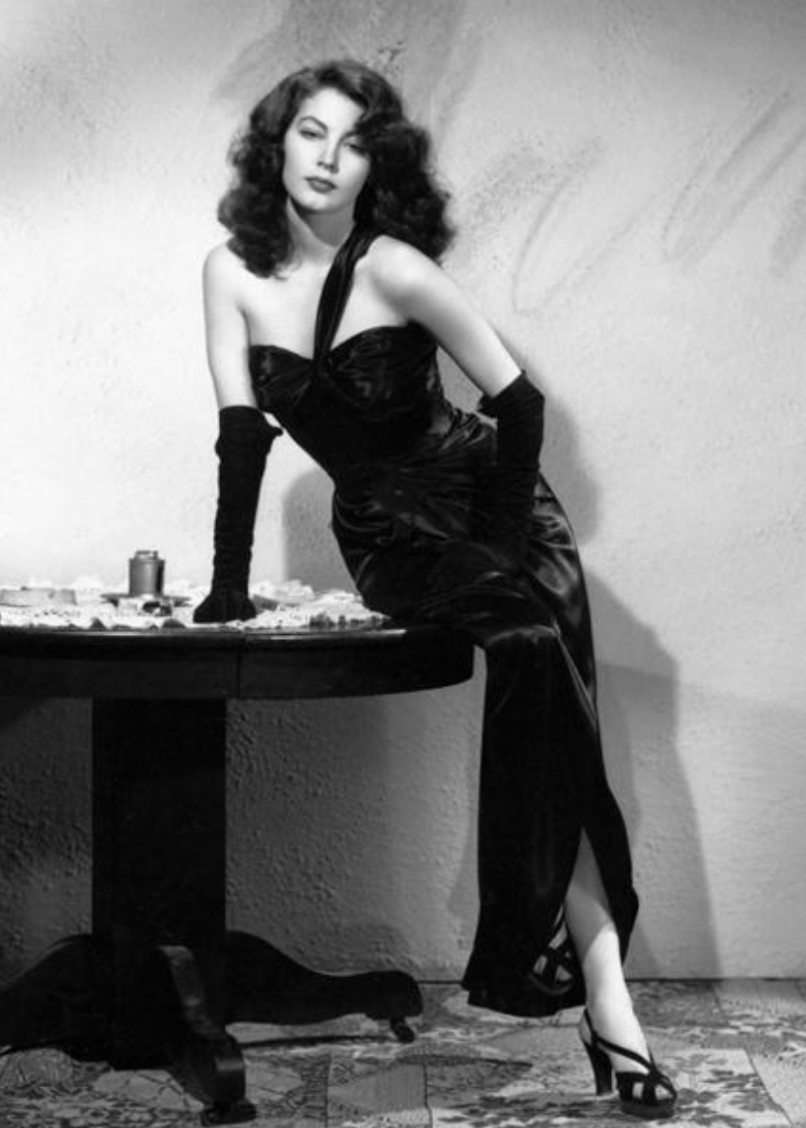
When down her weedy trophies and herself
Fell in the weeping brook. Her clothes spread wide
And mermaid-like, awhile they bore her up;
Which time she chanted snatches of old tunes,
As one incapable of her own distress,
Or like a creature native and endued unto
that element. But long it could not be
Till that her garments, heavy with their drink,
Pulled the poor wretch from her melodious lay
To muddy death.
~ Hamlet, Act 4 Scene 7
When down her weedy trophies and herself
Fell in the weeping brook. Her clothes spread wide
And mermaid-like, awhile they bore her up;
Which time she chanted snatches of old tunes,
As one incapable of her own distress,
Or like a creature native and endued unto
that element. But long it could not be
Till that her garments, heavy with their drink,
Pulled the poor wretch from her melodious lay
To muddy death.
~ Hamlet, Act 4 Scene 7

Ophelia (detail) by Sir John Everett Millais, 1851/52

Ophelia (detail) by Sir John Everett Millais, 1851/52
Floating underneath a willow, the saddest of all trees, surrounded by the fabric of her dress and the flowers she collected, there drowns a woman ridden by grief and driven to madness by love: Ophelia. As an obedient and angelic creature, she was loved not only by the other characters in Hamlet but also by countless late 19th century painters. In the Victorian era, depicting women as femmes fragiles was all the rage (Frey, 2023). They embodied the ethereal counterpart to the male down-to-earth strength, and they were either madly in love, or terminally ill, or just generally terribly weak, innocent, and brainless (Jones, 2015). Any one or multiple of those attributes made them appear, well, fragile. Like a damsel in distress, yet worse, because not even the prince could rescue them in the end.
While the painters’ love for the femme fragile as a motif was short-lived, the archetype has existed long before and after the fragility hype. To the present day, it is regularly reproduced in literature and film, and is certainly engrained in female stereotypes (Follmann, 2018). Think of the five sisters in The Virgin Suicides (pure, untouchable, doomed, eventually dead), or the main character in The Bell Jar (naïve, troubled, struggling with mental illness, poetic), or even some aspects of the female characters in films ranging from Casablanca to Pretty Women. All these characters suggest that, eventually, women are dependent on men and rely on their help; women are irrational, overly emotional, seek distraction and replace missing validation from men with shopping or wine at the kitchen counter (modern version). These characters instil and reinforce ideas about how women ought to look, dress, behave, interact, and think – the exact gender norms that many of us are trying to fight and overcome. And it strikes again now with infantilising ‘girl math’ and romanticised delusion; it’s fragility in disguise.
While the femme fragile’s moment of fame has certainly passed, her notorious counterpart is still breaking hearts left and right: the femme fatale. Given the archetype is probably as old as humanity’s ability to tell stories, great examples can already be found in Helen of Troy and Cleopatra. Modern adaptations of the femme fatale character include films such as Basic Instinct, Gone Girl, or virtually anything film noir (prime example: Rebecca). She truly is the main character, oozing sex appeal and outrageous beauty, but it is her assertive, manipulative, and devilish nature that makes her irresistibly dangerous. While this may sound very feminist and sex-positive to some, it also reinforces ideas about women that are utterly unrealistic and problematic: women are manipulative; hot and dangerous women are every man’s weakness; women are (more) successful when using their sex-appeal instead of their skill, intelligence, or ability.

Ava Gardner in The Killers (1946)
Undoubtedly, these archetypes serve opposite functions in their respective works of art. Especially in regard to their sexuality, the contrast between the innocent and child-like femme fragile and the dangerous and seductive femme fatale could not be starker. However, through the lens of beauty, emotions, and relationships, they suddenly appear to be two sides of the same coin.
Beauty itself is fragile and fleeting, yet (or maybe for this very reason) powerful. Both femmes are first and foremost defined by their looks, which are very obviously catering to the male gaze. Their beauty motivates most of their interactions with other characters, it makes them worth fighting, crying, or dying for. This appears to put the femmes in a position of power and status, but beware that the plot centres around his desire for her beauty and therefore her life revolves around his.
Both archetypes are, next to their beauty, defined by their emotions. The femme fragile is consumed by love or madness, behaves irrationally, and eventually succumbs to her emotional distress. Similarly, the femme fatale is always seeking power and dominance over her admirers (read: victims), but her background story often reveals that her motives are ultimately emotional (Arsheep, 2023). Often, she has experienced tragedy or hardship, and life has simply shaped her into the woman she is now – making her a deeply hurt and flawed character. This central role of emotions for the identity of both archetypes once again reinforces the notion that women are the emotional gender. However, this also shows that fragility and emotionality are not inherently connected to weakness, but rather also to power.
“Even though the femmes exhibit each of the elements differently, taken together, they paint a more realistic picture.”
Indeed, this power of emotions is crucial to the plot: It is used to motivate other characters to certain actions, frequently leading to their death or despair. The femme fatale actively uses her emotional upper hand to deceive, manipulate, and lead on her male counterparts. She therefore embodies a woman that takes revenge in a patriarchal system, as she has freed herself from the sexual and normative constraints of the time (Arsheep, 2023). Conversely, the femme fragile adheres to these norms faultlessly, but through her death or madness she eventually becomes unreachable to her admirers. Whoever was fighting to possess her is usually left behind in pain while she transcends traditional ideas of the conquerable woman.
After all, these seemingly polar opposite archetypes might just be the same character in very different fonts. Even though the femmes exhibit each of the elements differently, taken together, they paint a more realistic picture. Real women most likely do not clearly identify with one or the other, since reality requires and allows for many shades of grey. Identities are more fluid than such a simple dichotomy. Fiction always takes elements of reality and uses them in a surrealistic, reductionist, and extreme way since the message travels from written words or flickering images to the receiver’s brain and should still evoke emotions in them. Although archetypes eventually remain elements of fiction, they can nevertheless influence stereotypes and norms strongly. Embracing elements of these archetypes as a woman in real-life is often reinforced and socially rewarded, e.g., conveying sexual innocence, or ticking all the right boxes of current beauty ideals. However, some of the more empowering aspects such as being assertive (without being hyper-attractive) or finding strength in one’s emotionality can still backfire, for example in the working environment (Brescoll & Uhlmann, 2008; Heilman, 2012).
While the archetypes might be successful tropes in the arts and media, we should not forget how unrealistic they are and therefore how unhealthy their influence on gender stereotypes and beauty norms can be. There is nothing wrong with being girly, living in your own fairy-tale, or embracing emotionality – just like there is nothing wrong with feeling comfortable in your sexuality, or wanting to become the untouchable main character career woman. Always remember that there is space for both Ophelia and Rebecca, and everything in between. We should not allow these archetypes to dictate the choices we make every day, because fortunately, reality does not play by the rules of fiction.<<
References
-
Arsheep, S.T. (2023). Who is the femme fatale and what does this archetype tell us about ourselves? https://countingstarsheep.com/who-is-the-femme-fatale-and-what-does-this-archetype-tell-us-about-ourselves/
-
Brescoll, V. L., & Uhlmann, E. L. (2008). Can an angry woman get ahead? Status conferral, gender, and expression of emotion in the workplace. Psychological science, 19(3), 268-275.
-
Jones, J. B. (2015). Fantastic Sexism? Subverting the Femme Fatale and Femme Fragile in the Fantastic Fiction of Machado de Assis. Brigham Young University.
-
Follmann, S. (2018). Oh so sensibel: Über das Bild der fragilen Frauen, die stets bemüht sind, ihre innere Leere zu füllen. https://editionf.com/fragile-frauen-innere-leere-frauenbild-michael-nast/
-
Frey, A. (2023). Meet the Femme Fragile, the Femme Fatale’s Counterpart. https://www.artandobject.com/news/meet-femme-fragile-femme-fatales-counterpart
-
Heilman, M. E. (2012). Gender stereotypes and workplace bias. Research in organizational Behavior, 32, 113-135.
-
Ophelia photo: https://smarthistory.org/millais-ophelia/
-
Ava Gardner photo: https://cdn.britannica.com/75/66175-050-30F48828/Ava-Gardner-The-Killers.jpg
Floating underneath a willow, the saddest of all trees, surrounded by the fabric of her dress and the flowers she collected, there drowns a woman ridden by grief and driven to madness by love: Ophelia. As an obedient and angelic creature, she was loved not only by the other characters in Hamlet but also by countless late 19th century painters. In the Victorian era, depicting women as femmes fragiles was all the rage (Frey, 2023). They embodied the ethereal counterpart to the male down-to-earth strength, and they were either madly in love, or terminally ill, or just generally terribly weak, innocent, and brainless (Jones, 2015). Any one or multiple of those attributes made them appear, well, fragile. Like a damsel in distress, yet worse, because not even the prince could rescue them in the end.
While the painters’ love for the femme fragile as a motif was short-lived, the archetype has existed long before and after the fragility hype. To the present day, it is regularly reproduced in literature and film, and is certainly engrained in female stereotypes (Follmann, 2018). Think of the five sisters in The Virgin Suicides (pure, untouchable, doomed, eventually dead), or the main character in The Bell Jar (naïve, troubled, struggling with mental illness, poetic), or even some aspects of the female characters in films ranging from Casablanca to Pretty Women. All these characters suggest that, eventually, women are dependent on men and rely on their help; women are irrational, overly emotional, seek distraction and replace missing validation from men with shopping or wine at the kitchen counter (modern version). These characters instil and reinforce ideas about how women ought to look, dress, behave, interact, and think – the exact gender norms that many of us are trying to fight and overcome. And it strikes again now with infantilising ‘girl math’ and romanticised delusion; it’s fragility in disguise.
While the femme fragile’s moment of fame has certainly passed, her notorious counterpart is still breaking hearts left and right: the femme fatale. Given the archetype is probably as old as humanity’s ability to tell stories, great examples can already be found in Helen of Troy and Cleopatra. Modern adaptations of the femme fatale character include films such as Basic Instinct, Gone Girl, or virtually anything film noir (prime example: Rebecca). She truly is the main character, oozing sex appeal and outrageous beauty, but it is her assertive, manipulative, and devilish nature that makes her irresistibly dangerous. While this may sound very feminist and sex-positive to some, it also reinforces ideas about women that are utterly unrealistic and problematic: women are manipulative; hot and dangerous women are every man’s weakness; women are (more) successful when using their sex-appeal instead of their skill, intelligence, or ability.

Ava Gardner in The Killers (1946)
Undoubtedly, these archetypes serve opposite functions in their respective works of art. Especially in regard to their sexuality, the contrast between the innocent and child-like femme fragile and the dangerous and seductive femme fatale could not be starker. However, through the lens of beauty, emotions, and relationships, they suddenly appear to be two sides of the same coin.
Beauty itself is fragile and fleeting, yet (or maybe for this very reason) powerful. Both femmes are first and foremost defined by their looks, which are very obviously catering to the male gaze. Their beauty motivates most of their interactions with other characters, it makes them worth fighting, crying, or dying for. This appears to put the femmes in a position of power and status, but beware that the plot centres around his desire for her beauty and therefore her life revolves around his.
Both archetypes are, next to their beauty, defined by their emotions. The femme fragile is consumed by love or madness, behaves irrationally, and eventually succumbs to her emotional distress. Similarly, the femme fatale is always seeking power and dominance over her admirers (read: victims), but her background story often reveals that her motives are ultimately emotional (Arsheep, 2023). Often, she has experienced tragedy or hardship, and life has simply shaped her into the woman she is now – making her a deeply hurt and flawed character. This central role of emotions for the identity of both archetypes once again reinforces the notion that women are the emotional gender. However, this also shows that fragility and emotionality are not inherently connected to weakness, but rather also to power.
“Even though the femmes exhibit each of the elements differently, taken together, they paint a more realistic picture.”
Indeed, this power of emotions is crucial to the plot: It is used to motivate other characters to certain actions, frequently leading to their death or despair. The femme fatale actively uses her emotional upper hand to deceive, manipulate, and lead on her male counterparts. She therefore embodies a woman that takes revenge in a patriarchal system, as she has freed herself from the sexual and normative constraints of the time (Arsheep, 2023). Conversely, the femme fragile adheres to these norms faultlessly, but through her death or madness she eventually becomes unreachable to her admirers. Whoever was fighting to possess her is usually left behind in pain while she transcends traditional ideas of the conquerable woman.
After all, these seemingly polar opposite archetypes might just be the same character in very different fonts. Even though the femmes exhibit each of the elements differently, taken together, they paint a more realistic picture. Real women most likely do not clearly identify with one or the other, since reality requires and allows for many shades of grey. Identities are more fluid than such a simple dichotomy. Fiction always takes elements of reality and uses them in a surrealistic, reductionist, and extreme way since the message travels from written words or flickering images to the receiver’s brain and should still evoke emotions in them. Although archetypes eventually remain elements of fiction, they can nevertheless influence stereotypes and norms strongly. Embracing elements of these archetypes as a woman in real-life is often reinforced and socially rewarded, e.g., conveying sexual innocence, or ticking all the right boxes of current beauty ideals. However, some of the more empowering aspects such as being assertive (without being hyper-attractive) or finding strength in one’s emotionality can still backfire, for example in the working environment (Brescoll & Uhlmann, 2008; Heilman, 2012).
While the archetypes might be successful tropes in the arts and media, we should not forget how unrealistic they are and therefore how unhealthy their influence on gender stereotypes and beauty norms can be. There is nothing wrong with being girly, living in your own fairy-tale, or embracing emotionality – just like there is nothing wrong with feeling comfortable in your sexuality, or wanting to become the untouchable main character career woman. Always remember that there is space for both Ophelia and Rebecca, and everything in between. We should not allow these archetypes to dictate the choices we make every day, because fortunately, reality does not play by the rules of fiction.<<
References
-
Arsheep, S.T. (2023). Who is the femme fatale and what does this archetype tell us about ourselves? https://countingstarsheep.com/who-is-the-femme-fatale-and-what-does-this-archetype-tell-us-about-ourselves/
-
Brescoll, V. L., & Uhlmann, E. L. (2008). Can an angry woman get ahead? Status conferral, gender, and expression of emotion in the workplace. Psychological science, 19(3), 268-275.
-
Jones, J. B. (2015). Fantastic Sexism? Subverting the Femme Fatale and Femme Fragile in the Fantastic Fiction of Machado de Assis. Brigham Young University.
-
Follmann, S. (2018). Oh so sensibel: Über das Bild der fragilen Frauen, die stets bemüht sind, ihre innere Leere zu füllen. https://editionf.com/fragile-frauen-innere-leere-frauenbild-michael-nast/
-
Frey, A. (2023). Meet the Femme Fragile, the Femme Fatale’s Counterpart. https://www.artandobject.com/news/meet-femme-fragile-femme-fatales-counterpart
-
Heilman, M. E. (2012). Gender stereotypes and workplace bias. Research in organizational Behavior, 32, 113-135.
-
Ophelia photo: https://smarthistory.org/millais-ophelia/
-
Ava Gardner photo: https://cdn.britannica.com/75/66175-050-30F48828/Ava-Gardner-The-Killers.jpg



